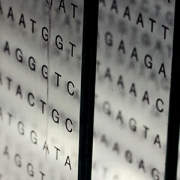Newborn screening: time for a genomic approach?
This week, we explore how genomics could help expand the newborn screening programme to test for many more genetic conditions
Newborn screening is an important part of neonatal care as it gives healthcare professionals a chance to intervene early and adapt treatment for the parent and baby. But what does the screening programme in the UK currently test for, and could it be improved?
The newborn blood spot screening programme
In the UK, newborns have a blood spot test (also known as the ‘heel prick test’), where four drops of blood are placed on a card and sent away for testing. It is usually done when babies are five days old.
Nine conditions are screened for by the test, including sickle cell disease, congenital hypothyroidism, cystic fibrosis and six metabolic conditions. In all these cases, early detection and treatment can prevent irreversible harm or potentially save the child’s life.
All the conditions are genetic in origin, but the type of test itself is not – rather, it looks for biomarkers that indicate the presence of the conditions. Each of the three non-metabolic conditions can be screened for individually, but the six metabolic conditions must be screened for as a group. You can read more about blood spot cards and how they are used here.
A positive screening result may need to be confirmed by a genetic test, but the early warning can be extremely valuable as clinicians can take immediate action while further tests are undertaken.
Genetic testing
There are many more genetic conditions not currently screened for by the blood spot test where early treatment or other management could improve prognosis.
“There are probably about 600 conditions where there is a potential early life intervention, and these all present before your fifth birthday” said Genomics England chief scientist Professor Sir Mark Caulfield, who has been part of an initiative to create an online compendium of genetic conditions with available treatments.
Scaling the current blood spot test up to screen for this many conditions is impossible, as not all the disorders would have a signature biomarker detectable in the blood. Additionally, even with the presence of a biomarker, repeated rounds of tests would have to be undertaken at different ages because not all biomarkers appear at the same time.
To expand the scope of what is possible, a genomic approach would be required.
“Genomics has the potential to identify a wider set of conditions than the current NHS newborn screening programme. This could offer us the ability to apply interventions at the earliest opportunity that could cure, prevent or slow down the progression of a range of illnesses and disabilities,” said Professor Caulfield. “It also has the potential to kick-start a revolution in the way we find, and make available, new diagnoses and treatments for children with rare but very serious diseases, and transform their life chances.”
Widening the discussion
Genomics England, the UK National Screening Committee and UK Research and Innovation have been engaging in a dialogue to gauge public opinion and understand issues raised by a genomic approach to newborn screening, including discussion around whole genome sequencing.
UK National Screening Committee chair, Professor Bob Steele said:
“The dialogue participants confirmed that in many ways, sequencing and analysing genomes is the easy part. The really difficult questions are around how predictive the results are, what conditions it would be acceptable to look for, what information to give to whom and when, and how to help parents make informed choices about tests that could have important implications for their child, themselves and maybe others in their family.”
For more information about the importance of genomics during and after pregnancy, visit our dedicated ‘Genomics in Midwifery’ webpage.
–









